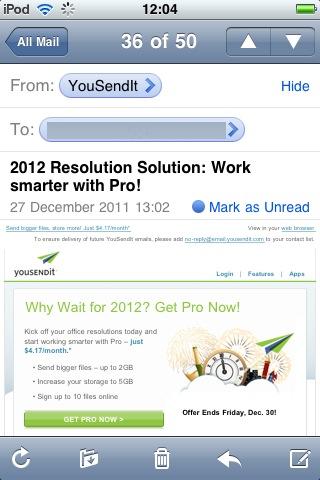Email marketing has always made a number of assumptions about subscribers. We assume that readers are interested in what we’re offering if we can just get the message right. We assume that emails are more effective and a lot cheaper than the kind of junk mail that clogs up physical mailboxes and weighs down postal deliverers. And we assume that when we contact subscribers they’re sitting in front of their computers, either at home or at the office, ready to give our copy their full and undivided attention.
Most of those assumptions remain unchallenged. Email marketing is still effective, provided the copy is right. It remains much easier, cheaper and less intrusive than delivering leaflets to thousands of homes.
But it’s no longer being read primarily at the desk.
According to a new study, email opens on mobile devices rose by 34 percent between April 2011 and September 2011 in comparison to the previous six months. At the same time, the number of opens that took place on webmail and desktop fell by 11 percent and 9.5 percent respectively. More and more people are checking their mail more frequently, on the move, on smaller screens and in smaller bites of time.
That creates a new challenge for email marketers. We don’t just have to think about what kind of subject line will grab attention but how that subject line will appear on different devices and how the message will look on preview panes. Sometimes, the differences can have a real effect.
Wild Photography Holidays, for example, a travel firm, sent an email at the end of 2011 to promote a number of its tours. In webmail, even without displaying images, the email just about passed muster.

The text is cut and the pictures, which are spectacular, are missing. But the headlines are large and the list of tours on the right are interesting and varied enough to invite clicks from people looking for a range of different vacations.
The same email, viewed on a smartphone, however, is almost unreadable.

The menus on the right are now too small and the grey font used for those larger headlines fades into the background. It’s hard to imagine someone who received that message on their iPhone squinting onto the screen to find out about the tour to Ladakh. And once they saw the message on their webmail, they’ll remember that they’ve already read it — and ignore it.
With a little forethought and some careful design though, those kinds of mistakes are avoidable. YouSendIt’s marketing emails might appear a great deal smaller on an iPhone but they manage to squeeze all the necessary content elements into the tiny pane.

The headline is clear, the image draws the eye, the offer stands out and the call to action button couldn’t be any bigger or harder to miss. Whether the subscriber is seeing the email at a café or at their desk, they know exactly what they need to do next.
As more of your subscribers start looking at your messages on smaller screens, you know what you need to do too.